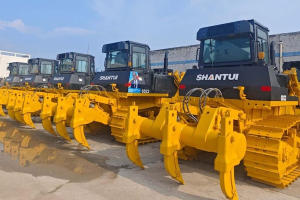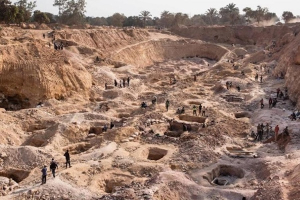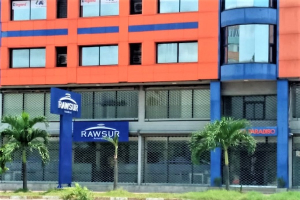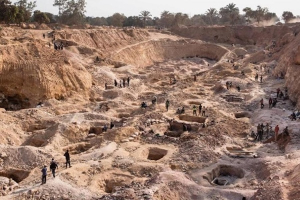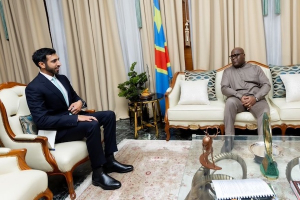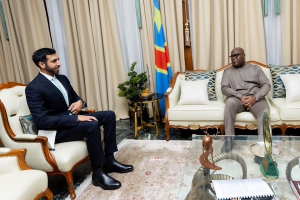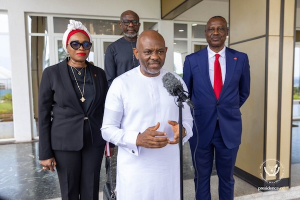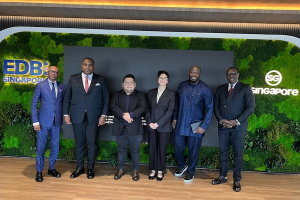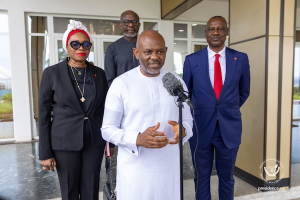Equipe Publication
Projet Guma : premiers équipements expédiés en RDC, mais des zones d’ombre persistent
En marge de sa mission de travail en République populaire de Chine, le ministre des Infrastructures et Travaux publics, John Banza Lunda, a supervisé, le 14 novembre dernier, l’expédition d’un lot de 200 engins de génie civil à destination de la RDC, selon une communication officielle de son ministère. Il s’agit de camions-bennes, de bulldozers et de véhicules d’itinérance.
Selon la même communication, ce premier lot constitue une partie d’une commande totale de 5 600 équipements prévue dans le cadre du partenariat conclu avec le groupe sud-africain Guma. En février 2024, lors du forum minier Mining Indaba en Afrique du Sud, la Primature avait annoncé la signature d’un contrat entre le gouvernement congolais, la Development Bank of Southern Africa (DBSA) et Guma Africa.
Toujours selon la Primature, ce contrat porte sur la construction de 180 000 kilomètres de routes pour un montant global de 450 millions de dollars américains. Le financement devait permettre l’acquisition des équipements de construction, la réhabilitation et l’entretien des routes par le ministère des ITPR, ainsi que le renforcement des capacités de l’Office des voiries et drainage (OVD) et de l’Office des routes (OR), incluant la formation des opérateurs et techniciens.
Zones d’ombre
Si la mise en œuvre était initialement prévue sur trois ans, le contrat n’aurait finalement été signé que le 29 août 2025, selon une communication du ministère des ITPR. Pour l’heure, le montage financier du projet demeure peu clair. Le ministère s’est limité à préciser qu’il est « financé sans garantie souveraine ». À l’observation, le partenariat s’apparente à un contrat de leasing indirect d’équipements de génie civil. Dans cette hypothèse, la DBSA jouerait le rôle de bailleur, Guma celui de fournisseur et l’État congolais celui de preneur. Ce dernier utiliserait ensuite les équipements pour construire et réhabiliter ses routes, et paierait des loyers destinés à couvrir le coût d’achat desdits équipements. Et ceux-ci ne deviendraient sa propriété qu’une fois l’argent complètement remboursé.
Les caractéristiques techniques des routes à construire ne sont pas encore connues, mais le coût annoncé laisse supposer qu’il s’agirait essentiellement de routes en terre. En février 2024, la Primature présentait ce programme comme « un véritable coup d’accélérateur pour le Programme de développement local des 145 territoires (PDL-145T) ».
Dans son deuxième volet, dont la mise en œuvre a débuté au troisième trimestre 2022, le PDL-145T prévoit la réhabilitation et l’entretien de plus de 38 000 km de routes de desserte agricole et d’ouvrages d’art, pour un coût total de 1,250 milliard de dollars, selon un rapport du ministère des Finances. Pour l’instant, on dispose pas d’éléments sur la manière dont les deux programmes s’articulent.
« Ce programme transformera la vie des Congolais, en réduisant les coûts de transport et en stimulant l’agriculture et l’industrie », déclarait le PDG du groupe Guma, Robert Gumede, lors de sa visite en RDC le 29 août dernier. Son objectif serait d’améliorer la connexion entre zones urbaines et rurales afin de faciliter la mobilité et de renforcer l’intégration régionale.
Pierre Mukoko et Timothée Manoke
Lire aussi :
Entretien de routes agricoles : le PNDA vise 707 km au Kasaï Central
Kongo central : la réhabilitation de 550 km de routes de desserte agricole lancé
Zones agricoles : Muhindo Nzangi et son projet de 11 000 km de voies de desserte
Kinshasa Extends Closure of 38 Mines to Curb M23 Funding
-
DR Congo's Mines Minister Louis Watum Kabamba signed an order on November 3, 2025, extending for six months the "red status" on 38 mining sites in North and South Kivu to limit revenue for the M23 rebel group.
-
The extension aims to reduce the financial resources of the rebels, as illegal mining activities are considered their primary source of funding, estimated at $300,000 to $800,000 per month.
-
The "red status" prohibits extraction and legal trade of minerals from these sites, although UN experts report systematic smuggling and mixing with Rwandan production.
According to an announcement by the Ministry of Mines, Minister Louis Watum Kabamba signed an order on November 3, 2025, extending for six months the "red status" applied to 38 mining sites in North Kivu and South Kivu. This decision prolongs an initial measure taken in February 2025 by his predecessor, originally valid for six months, targeting concessions in Masisi and Kalehe territories, which have fallen under M23 influence since 2024.
This extension aligns with the Congolese government's strategy to reduce rebel financial resources. Kinshasa considers illegal mining activities the movement's primary source of financing. In October 2024, Bintou Keita, head of MONUSCO, estimated that taxes imposed by rebels in mining areas under their control generated approximately $300,000 per month. A report published in December of the same year valued these monthly revenues at $800,000.
These revenues would supplement those derived from the Twangiza gold mine in South Kivu, where the operating company claims illicit sales by rebels reached $70 million since May 2025. These estimates illustrate the mining sector's importance in financing the rebellion.
According to the order signed on November 3, the new six-month period commences on August 12, 2025, the expiration date of the previous regulatory act. The "red status" classification prohibits all extraction activities and renders illegal the commercialization of coltan, cassiterite, and other minerals originating from these sites, thus limiting their access to formal channels.
To circumvent these restrictions, smuggling networks rely on already documented money laundering mechanisms. The United Nations Group of Experts report published in July 2025 indicates that 3T minerals—tin (cassiterite), tungsten (wolframite), and tantalum (coltan)—originating from M23-controlled areas are systematically mixed with Rwandan production before export. Experts report approximately 686 tons of minerals clandestinely exited the region since January 2025.
These elements reinforce the Congolese government's position, which views the mining sector as an essential lever to dry up rebel financing.
This article was initially published in French by Timothée Manoke
Adapted in English by Ange Jason Quenum
Assurance : RAWSUR décroche le double A de GCR Ratings
Selon un communiqué de RAWSUR Assurance, ses deux filiales — RAWSUR SA et RAWSUR LIFE SA — ont obtenu la notation AA (CD) avec perspective stable, délivrée par GCR Ratings, une agence affiliée à Moody’s Investors Service, à l’issue d’un audit initié au premier trimestre 2025.
Pour l’assureur, cette notation confirme sa capacité à honorer ses engagements à long terme. Elle constitue une reconnaissance de la solidité de son bilan, de sa liquidité, de sa gouvernance, ainsi que de la qualité de sa gestion des risques.
La notation nationale AA (CD) attribuée aux deux entités indique une « très forte crédibilité relative » parmi les acteurs domestiques congolais. Les échelles nationales de Moody’s sont conçues pour mesurer la solvabilité des émetteurs au sein d’un même pays, sans comparaison directe avec les notations attribuées à des émetteurs étrangers.
Moody’s précise également que la perspective stable signifie qu’aucune modification significative de la note n’est anticipée à court ou moyen terme, sur la base des informations disponibles lors de l’évaluation. L’agence rappelle toutefois qu’une notation reste une opinion, susceptible d’évoluer si la situation financière ou le contexte change.
Le directeur général de RAWSUR SA, Tarik Lefriyekh, voit dans cette reconnaissance la validation de la vision de long terme de l’entreprise. « Elle confère à nos clients et partenaires une assurance absolue quant à la pérennité de notre modèle et à notre capacité à jouer un rôle de premier plan dans la sécurisation des investissements majeurs en RDC », commente-t-il.
De son côté, le directeur général de RAWSUR LIFE SA, Hughes Toto, estime que « cette notation renforce notre mandat : celui d’insuffler un niveau de confiance sans précédent dans le secteur. Elle est un signal fort envoyé aux investisseurs nationaux et internationaux, attestant que la RDC dispose désormais d’institutions financières capables de répondre aux exigences de solidité les plus élevées ».
Boaz Kabeya
Lire aussi :
Réforme des assurances : la RDC fait marche arrière, après l’adoption d’un projet de loi
RDC-Chine: une coopération se met en place contre l’évasion des primes d’assurance
Assurance : un marché en croissance en RDC, projeté à plus d’un milliard $ d’ici 10 ans
Mines : Kinshasa prolonge la fermeture de 38 sites pour limiter les revenus du M23
D’après une annonce du ministère des Mines, le ministre Louis Watum Kabamba a signé, le 3 novembre 2025, un arrêté prorogeant pour six mois le statut « rouge » appliqué à 38 sites miniers du Nord-Kivu et du Sud-Kivu. Cette décision prolonge une première mesure prise en février 2025 par son prédécesseur, valable initialement six mois, et visant les concessions situées dans les territoires de Masisi et de Kalehe, passées sous l’influence du M23 depuis 2024.
Cette prorogation s’inscrit dans la stratégie du gouvernement congolais visant à réduire les ressources financières des rebelles. Kinshasa considère en effet les activités minières illégales comme la principale source de financement du mouvement. En octobre 2024, Bintou Keita, cheffe de la Monusco, estimait que les taxes imposées par les rebelles dans les zones minières sous leur contrôle généraient environ 300 000 dollars par mois. Un rapport publié en décembre de la même année chiffrait ces recettes mensuelles à 800 000 dollars.
À ces revenus s’ajouteraient ceux tirés de la mine d’or de Twangiza, au Sud-Kivu, où l’entreprise exploitante affirme que des ventes illicites réalisées par les rebelles auraient atteint 70 millions de dollars depuis mai 2025. Ces estimations illustrent l’importance du secteur minier dans le financement de la rébellion.
Selon l’arrêté signé le 3 novembre, la nouvelle période de six mois est comptée à partir du 12 août 2025, date d’expiration du précédent acte réglementaire. Le classement « rouge » interdit toute activité d’extraction et rend illégale la commercialisation du coltan, de la cassitérite et d’autres minerais provenant de ces sites, ce qui limite leur accès aux circuits formels.
Pour contourner ces restrictions, les réseaux de contrebande s’appuient sur des mécanismes de blanchiment déjà documentés. Le rapport du Groupe d’experts des Nations unies publié en juillet 2025 indique que les minerais 3T - étain (cassitérite), le tungstène (wolframite) et le tantale (coltan)- provenant des zones contrôlées par le M23 sont systématiquement mélangés à la production rwandaise avant leur exportation. Les experts font état d’environ 686 tonnes de minerais sorties clandestinement de la région depuis janvier 2025.
Ces éléments confortent la position du gouvernement congolais, qui considère la filière minière comme un levier essentiel pour assécher le financement de la rébellion.
Timothée Manoke
Lire aussi :
Conflit à l’est de la RDC : 38 sites miniers interdits d’exploitation pour asphyxier le M23
DRC in Talks With Singapore Agencies to Advance Industrial Projects
The Democratic Republic of Congo’s Industrial Promotion Fund (FPI) is seeking partnerships with three major Singaporean economic bodies: the Singapore Cooperation Enterprise (SCE), the Economic Development Board (EDB) and Enterprise Singapore (ESG).
FPI Director-General Hervé Claude Ntumba Batukonke met officials from the three institutions during an economic mission to Singapore from November 1 to 8, 2025. The visit was held at the invitation of Embed Financial Group Holdings (EFGH Singapore).
According to an FPI statement, talks with SCE—which develops government-to-government partnerships and capacity-building initiatives—focused on industrial policy, digitalization and skills development. SCE expressed support for reforms underway in the DRC in these areas.
Discussions with the EDB, the agency responsible for attracting investment in sectors such as technology, finance, industry and biotechnology, highlighted opportunities to draw investors into Congolese industrial projects.
FPI also met with Enterprise Singapore, which sees the DRC as a potential partner for future industrial projects. ESG supports the international expansion of Singaporean companies and says it has nearly $20 billion in committed investments across African projects. The agency provides financing, technical support and training for small and medium-sized enterprises.
According to Ntumba, the meetings highlighted the DRC’s economic strengths and presented new investment opportunities in industry. Following the mission, FPI and the Singaporean agencies agreed on several next steps. These include formalizing a bilateral cooperation framework, preparing FPI’s participation in the 2027 International Conference with a list of priority projects, and establishing a mechanism to monitor the progress of investment commitments.
Ronsard Luabeya
DRC, UAE Discuss Potential Abu Dhabi Ports Investment in Matadi and Boma
Abu Dhabi Ports, the Emirati state-owned company, is considering investments in the Democratic Republic of Congo’s (DRC) Matadi and Boma ports. The potential projects were discussed during a meeting between President Félix-Antoine Tshisekedi and Emirati Minister of State for Foreign Affairs Sheikh Shakhboot Nahyan Al Nahyan on November 16, 2025.
No details were disclosed on the scale of Abu Dhabi Ports’ plans. According to the Congolese Presidency, the port initiatives fall within a wider infrastructure program that includes the Lobito Corridor, two dry ports, and road links from Kolwezi to Dilolo, as well as connections between the DRC, Angola, and Zambia.
The initiative aims to strengthen economic cooperation between the two countries. The Presidency said talks also covered the mining sector, the exchange of financial intelligence to combat money laundering and terrorist financing, and cooperation between the two central banks. Both sides discussed completing a long-delayed free trade agreement and organizing an economic forum to attract investment.
Between 2021 and 2023, Congolese exports to the UAE averaged $1.059 billion per year, compared with $1.89 billion in imports, leaving an average annual trade deficit of $650 million. Exports are dominated by mining products such as refined copper, gold, and diamonds.
Trade could increase following the acquisition by Emirati conglomerate IRH/IHC of a 56% stake in Alphamin Resources, the owner of the Bisie tin mine, which strengthens the UAE’s presence in the DRC’s mining sector.
Two other Emirati companies, Lone Star Ltd and Business Gate, have also expressed interest in energy projects in Tshopo Province, particularly in renewable energy.
Boaz Kabeya
Ports, routes, mines… : ces secteurs visés par les Émirats arabes unis en RDC
L’entreprise publique émiratie Abu Dhabi Ports envisage d’investir dans les ports de Matadi et de Boma. La question a été évoquée lors de l’audience que le président de la République, Félix-Antoine Tshisekedi, a accordé le 16 novembre 2025 au ministre d’État émirati en charge des Affaires étrangères, Sheikh Shakhboot Nahyan Al Nahyan.
À ce stade, aucun détail supplémentaire n’a été communiqué sur les ambitions d’Abu Dhabi Ports. Mais selon la présidence de la République démocratique du Congo (RDC), ces projets s’inscrivent dans un programme plus vaste incluant la construction du corridor de Lobito, de deux ports secs, ainsi que de routes reliant Kolwezi à Dilolo, et la RDC à l’Angola et à la Zambie.
Cet ensemble s’inscrit dans une volonté de dynamiser la coopération économique entre les deux pays. Toujours selon la présidence congolaise, les échanges entre Tshisekedi et son hôte ont également porté sur le secteur minier, l’échange de renseignements financiers pour lutter contre le blanchiment d’argent et le financement du terrorisme, ainsi que sur une collaboration entre les banques centrales. Les deux parties ont évoqué la finalisation d’un accord de libre-échange attendu depuis plusieurs mois et la tenue d’un forum économique destiné à mobiliser des financements.
Entre 2021 et 2023, les exportations congolaises vers les Émirats ont atteint en moyenne 1,059 milliard de dollars par an, contre 1,89 milliard de dollars d’importations, générant un déficit commercial annuel moyen de 831 millions de dollars. Ces exportations sont majoritairement composées de produits miniers — cuivre raffiné, or et diamants. Elles pourraient se renforcer avec l’acquisition par le conglomérat émirati IRH/IHC de 56 % d’Alphamin Resources, propriétaire de la mine d’étain de Bisie, ce qui renforce la présence des Émirats dans le secteur minier congolais.
Deux sociétés émiraties, Lone Star Ltd et Business Gate, ont également manifesté leur intérêt pour des projets énergétiques dans la province de la Tshopo, notamment dans le secteur des énergies renouvelables.
Boaz Kabeya
Lire aussi :
Étain : l’Émirati IRH conclut un deal à 367 millions $ pour prendre le contrôle de Bisie
L’Émirati NG9 Holding intéressé par les projets de Buenassa Resources et Kipay Energy en RDC
Accord de libre-échange avec les Émirats : la RDC vise 3 milliards $ d’exportations d’ici 2030
UBA DRC: Tony Elumelu Announces “Congolization” of Management
- UBA will appoint a Congolese national as CEO of UBA DRC and add nine Congolese board members.
- The bank plans to expand from 3 to 21 branches by 2028 and target USD 1.8 billion in deposits.
- UBA DRC grew net profit 388% in 2024, reaching 21 billion naira.
United Bank for Africa Chairman Tony Elumelu announced a sweeping localisation plan for UBA Democratic Republic of Congo after meeting President Félix Tshisekedi on November 16, 2025. Elumelu outlined the changes during a visit to Kinshasa, according to a summary posted by the presidency on X.
The presidency stated that UBA DRC will appoint a Congolese national to lead the subsidiary. It added that nine Congolese members will join the board as part of a strategy to progressively “Congolize” the management structure. The subsidiary is currently led by Nigerian national Sampson Aneke, who is supported by Deputy Managing Director Gisèle Bondo, appointed in February 2024.
Elumelu said the bank plans to extend its branch network into several provinces across the country. “We believe in the potential of the DRC, especially its youth. The opening of new branches will help create jobs,” he said.
UBA has operated in the DRC since 2011. The bank currently maintains branches in Kinshasa, Lubumbashi and Matadi. The group detailed in its 2024 Pillar Report that its 2024–2028 strategic plan targets a major expansion—growing from three to 21 branches by 2028 and increasing its ATM network. The subsidiary also aims to reach a deposit base of $1.8 billion over the same period.
UBA DRC significantly increased its contribution to group results in 2024. The bank reported a net profit of 21 billion naira, compared with 4.3 billion naira in 2023. This performance marks a 388% year-on-year increase, according to documents reviewed by Bankable. The results mainly reflect growth in operating income, which rose from 4.3 billion to 22.8 billion naira.
Elumelu said the group also plans to expand its involvement in infrastructure financing in the DRC. Through the Tony Elumelu Foundation, he reaffirmed the bank’s commitment to supporting local entrepreneurship. Since the launch of the foundation’s programme, 350 young Congolese entrepreneurs have received financial support.
This article was initially published in French by Ronsard Luabeya
Adapted in English by Ange Jason Quenum
Financement des projets : le FPI prospecte de nouveaux partenariats à Singapour
Le Fonds de Promotion de l’Industrie (FPI) a exprimé son intérêt pour nouer des partenariats avec trois institutions économiques de Singapour : la Singapore Cooperation Enterprise (SCE), l’Economic Development Board (EDB) et Enterprise Singapore (ESG). Son directeur général, Hervé Claude Ntumba Batukonke, a rencontré les responsables de ces agences lors d’une mission de prospection économique effectuée à Singapour du 1ᵉʳ au 8 novembre 2025, à l’invitation de Embed Financial Group Holdings (EFGH Singapore).
Selon une note du FPI, les échanges avec la Singapore Cooperation Enterprise ont porté sur la gouvernance industrielle, la digitalisation et le transfert de compétences. La SCE, chargée de concevoir et de mettre en œuvre des partenariats gouvernement-gouvernement (G2G) et des programmes de renforcement des capacités, a salué les réformes en cours en RDC dans ces domaines.
La rencontre avec l’Economic Development Board, organisme chargé de l’attraction des investissements dans les technologies, la finance, l’industrie et la biotechnologie, a permis d’identifier des pistes de coopération pour mobiliser des investisseurs autour des projets industriels congolais.
Des discussions ont également eu lieu avec Enterprise Singapore, qui voit en la RDC un partenaire potentiel pour ses futures initiatives industrielles. Cette institution, chargée de soutenir l’expansion internationale des entreprises singapouriennes, revendique près de 20 milliards de dollars d’investissements engagés sur divers projets en Afrique. L’agence accompagne notamment les PME à travers le financement, l’assistance technique et la formation.
Selon Hervé Claude Ntumba, ces rencontres ont permis de mettre en valeur les atouts économiques de la RDC et de promouvoir de nouvelles opportunités d’investissement dans le secteur industriel. À l’issue de la mission, le FPI et les agences singapouriennes ont convenu de travailler à la formalisation d’un cadre de coopération bilatérale, de préparer la participation du FPI à la Conférence internationale de 2027 avec une liste de projets prioritaires, et de mettre en place un mécanisme de suivi pour accompagner la concrétisation des intentions d’investissement.
Ronsard Luabeya
Lire aussi :
Financement des projets : le FPI explore un partenariat avec la SFI
UBA RDC : Tony Elumelu annonce la congolisation du management
En visite en République démocratique du Congo, le président du conseil d’administration du groupe United Bank for Africa (UBA), Tony Elumelu, a annoncé d’importants ajustements de gouvernance au sein de la filiale congolaise. L’annonce a été faite à l’issue d’une audience accordée, le 16 novembre 2025, par le président Félix Tshisekedi.
Selon le compte rendu de la présidence publié sur X, UBA RDC sera désormais dirigée par un Congolais. Par ailleurs, neuf Congolais feront leur entrée au conseil d’administration, dans le cadre d’une stratégie de congolisation progressive du management. La filiale est actuellement dirigée par le Nigérian Sampson Aneke, secondé par Gisèle Bondo, nommée directrice générale adjointe en février 2024.
Tony Elumelu a également indiqué que le groupe prévoit d’étendre son réseau bancaire à travers plusieurs provinces du pays. « Nous croyons au potentiel de la RDC, notamment de sa jeunesse. L’ouverture de nouvelles agences contribuera à créer des emplois », a-t-il déclaré.
Présente en RDC depuis 2011, UBA n’opère aujourd’hui que dans trois villes : Kinshasa, Lubumbashi et Matadi. Selon son rapport Pilier 2024, son plan stratégique 2024-2028 prévoit une expansion majeure, avec le passage de 3 à 21 agences d’ici 2028, ainsi qu’un renforcement du réseau de distributeurs automatiques. La banque vise également une base de dépôts de 1,8 milliard USD à cet horizon.
Sur le plan financier, UBA RDC a significativement accru sa contribution aux performances du groupe. En 2024, son bénéfice net a atteint 21 milliards de nairas, contre 4,3 milliards en 2023, soit une hausse annuelle de 388 %, selon des documents consultés par Bankable. Cette performance est principalement attribuée à la forte croissance du résultat d’exploitation, passé de 4,3 milliards à 22,8 milliards de nairas sur la même période.
Tony Elumelu a ajouté que le groupe s’intéresse aussi au financement d’infrastructures en RDC. À travers la Fondation Tony Elumelu, il a réitéré son engagement en faveur de l’entrepreneuriat local. Depuis le lancement du programme, 350 jeunes entrepreneurs congolais ont bénéficié d’un appui financier.
Ronsard Luabeya
Lire aussi :
UBA RDC vise une multiplication de ses dépôts pour atteindre 1,8 milliard $ d’ici 2028
UBA: la contribution de la RDC au bénéfice du groupe multipliée par 5 en 2024





